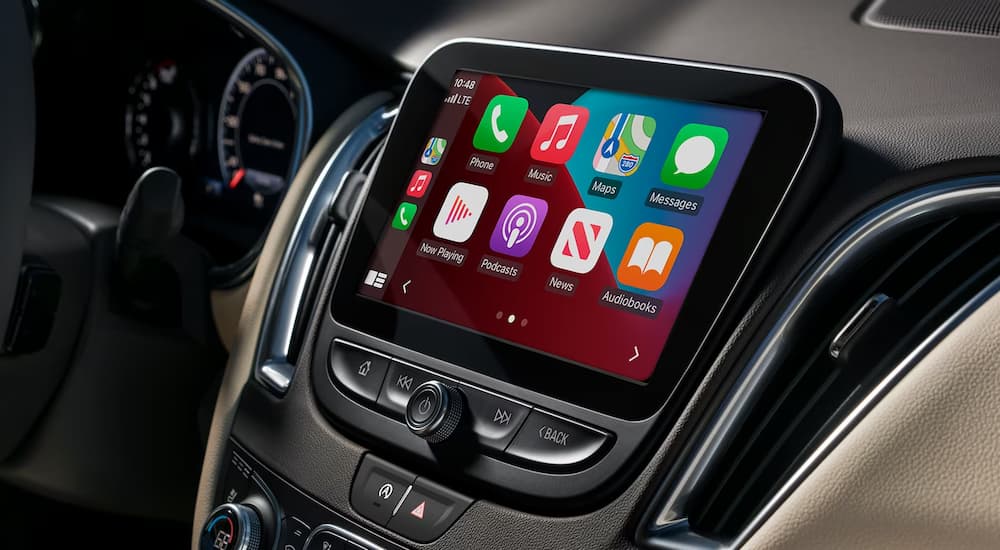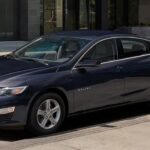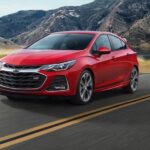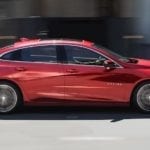Are sedans a dying breed? With one look around, it’s undeniable that sedans are outnumbered. Trucks and SUVs rule the American landscape because we live in an era where “bigger is better,” and we’re always in pursuit of more: we want more features, more capability, more stuff—more of everything. And while this love affair with bigger vehicles and our insatiable need for more isn’t necessarily bad, it’s significantly impacted the auto industry.
We turn to larger vehicles to meet the demands of our lives, whether we need a reliable workhorse or a spacious SUV to accommodate our family and cargo. However, sedans like the Chevy Malibu for sale on lots around the country still have a solid footing in the landscape even without its higher driving position and SUV-like styling. How so? Chevrolet capitalizes on our hunger for more by making the Malibu the most fuel-efficient in its lineup, packing it with features that offer exceptional value compared to rival sedans and subcompact SUVs.
#1) Affordability
The Malibu is the second most affordable vehicle in the Chevy lineup but undeniably the best value-oriented. The Trailblazer takes the top spot here, with its starting price of $22,100 in 2023, but drivers must compromise performance to keep this SUV’s cost low. For $25,000, you can get behind the wheel of the 2023 Malibu and enjoy the turbocharged performance of a 1.5L engine while saving more at the pump and reaping the rewards of more standard features, like an expansive 8.0-inch center touchscreen display, the Chevy infotainment system with seamless smartphone integration, and the standard Chevy Safety Assist suite.
Unsurprisingly, you have to make the same compromise when venturing beyond the Chevy lineup. Subcompact SUVs like the Hyundai Venue, Kia Soul, and Nissan Kicks might have the basic design features of an SUV, but they offer far less than the best-selling Malibu. These SUVs are underpowered and equipped with far less, with their automakers forcing you to spend more for a top-tier trim. Instead, you could save time and money by investing in the Malibu and enjoy the perks of a value-packed lineup and stylish packages like the Midnight Edition, Redline Edition, and Sport Edition.

#2) Performance
Performance is another key area where the Chevy Malibu has an undeniable advantage over its subcompact SUV rivals. Chevrolet is well-known for its engaging engines, and the 2023 Malibu is no exception. This midsize sedan rolls off Chevrolet’s production line with a 1.5L turbocharged inline-four and continuously variable transmission. The combination produces 160 hp and 184 lb-ft of torque, making the Malibu engaging and fun to drive.
It’s easy to think that subcompact SUVs should be more powerful because of their designs, but that isn’t always the case. Instead, many subcompact models are underpowered, giving the Malibu more room to shine. For example, the Hyundai Venue, Nissan Kicks, and Chevrolet Trax leave a lot to be desired when it comes to performance.
The Venue and Kicks have inline-four engines that deliver around 121 hp and 113 lb-ft of torque. The Trax sees a slight boost from Chevrolet’s turbocharged inline-three, which produces 137 hp and 162 lb-ft of torque. However, that’s still a far cry from the Malibu’s heartbeat. Not even a 2.0L inline-four in the Kia Soul, Kia Seltos, or Hyundai Kona can compete, with their engines producing a mere 147 hp and 132 lb-ft of torque.
#3) Efficiency
The Malibu’s calling card is its efficiency, with this midsize sedan earning top honors as the most efficient in the Chevrolet lineup. The sedan averages 27 MPG in the city and 35 MPG on the highway, guaranteeing you save more at the pump without compromising performance and its engaging driving demeanor. Alternatively, the rest of the Chevy lineup doesn’t match the Malibu’s fuel efficiency, with models like the Trax and Trailblazer averaging 32 to 33 MPG on the highway. Not even the Equinox can compete, with the popular SUV averaging 26 MPG in the city and 31 MPG on the highway.
We see similar results when comparing subcompact SUVs, which is surprising considering many produce less horsepower and torque. This shows how much automakers require drivers to compromise, with options like the Kicks, Soul, Kona, and Venue underpowered and still guzzling fuel. You’d expect a lower output to yield better fuel economy, but that isn’t the case. Instead, many subcompact SUVs offer comparable averages ranging between 28 MPG in the city and 34 MPG on the highway.
#4) Dimensions
Looking at the Malibu’s dimensions compared to Chevy SUVs like the Trailblazer and Trax tells more of the story and what you can expect regarding comfort and spaciousness in the cabin. As a midsize sedan, the Malibu doesn’t offer the cargo capacity you’ll find on the Trailblazer and Trax, but that’s expected. Instead, the Malibu focus
es on driver and passenger comfort, with an extensive cabin that yields a passenger volume of 102.9 cu.ft. The Trailblazer and Trax fall slightly behind, with volumes of 98.2 and 99.8, respectively.
The Malibu’s larger passenger volume and ample head, leg, shoulder, and hip room reflect the sedan’s longer wheelbase and wider stance. There’s more room to work with, considering the 111.4-inch wheelbase sets the stage for the Malibu’s 194.2-inch length and 73.0-inch width. Alternatively, the Trailblazer and Trax are noticeably shorter, gaining an advantage only in height as the Trailblazer stretches 173.5 inches and the Trax 178.6 inches. While they tower over the Malibu at over 60 inches, don’t expect this to translate to more room in either row.
With its longer wheelbase, the Malibu makes the most of its cabin and offers 39.1 inches of headroom, 41.5 inches of legroom, 58.5 inches of shoulder room, and 54.1 inches of hip room in the front row. The Trailblazer is more cramped all around, with its front-row dimensions measuring 38.3 inches (head), 40.9 inches (leg), 55.4 inches (shoulder), and 52.3 inches (hip). Moving to the second row, the Malibu offers comparable and even more space than its Chevy rivals. For example, the Malibu’s 37.5 inches of headroom beats the Trailblazer’s 36.8 inches when outfitted with a sunroof. Likewise, you’ll find more shoulder and hip room in the Malibu’s second row, with comparable legroom at 38.1 inches. The Trax is only slightly larger at 38.7 inches, which is hardly noticeable.
#5) Technologies
Finally, the Malibu offers a significant value that is nearly impossible to beat when shopping beyond the Chevrolet lineup. Chevrolet does an outstanding job of giving drivers more for their money by equipping the midsize sedan with an expansive 8.0-inch center touchscreen display and many standard features, like smartphone integration via Apple CarPlay and Android Auto, and the Chevy Safety Assist suite. You’ll also find the sedan has a long list of optional upgrades, like Alexa Built-In, wireless charging, a Wi-Fi hotspot, wireless smartphone integration, and navigation.
Rivals like the Nissan Kicks, Volkswagen Taos, and Subaru Crosstrek pale in comparison. While smartphone integration is standard, these subcompact SUVs have smaller displays, with the Taos offering a tiny 6.5-inch display and the Kicks and Crosstrek fitted with 7.0-inch displays. Moreover, investing in a Malibu also means gaining more standard technologies working behind the scenes, like the high-definition rear vision camera, Rear Park Assist, and Teen Driver mode. Chevrolet’s exclusive Teen Driver technology gives the Malibu another obvious advantage, making it perfect for young drivers as it offers coachable driving tools to create safer driving habits.
The Final Verdict
While there’s an undeniable rush to drive trucks and SUVs, sedans like the best-selling Malibu prove the demand for efficiency and value is still prominent in the American automotive landscape. The Malibu offers the best fuel economy in the Chevrolet lineup, but it also outperforms and outshines subcompact SUVs from Kia, Hyundai, Nissan, and Subaru. The same is true when comparing technologies, features, and dimensions, with the Malibu satiating the need for more in a midsize, value-oriented package that promises more savings and more responsiveness than most expect.





